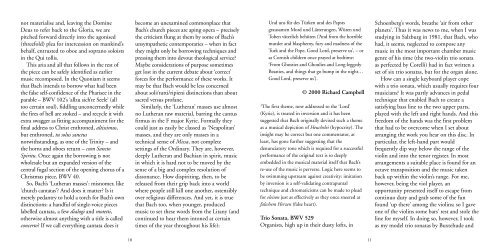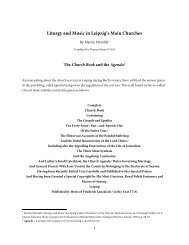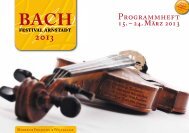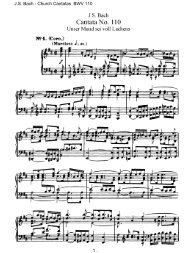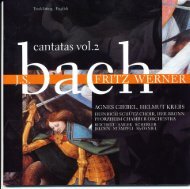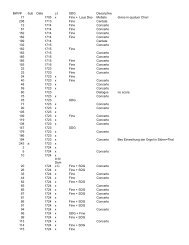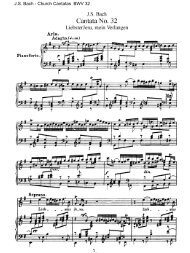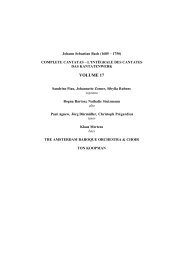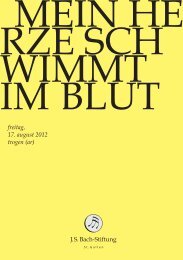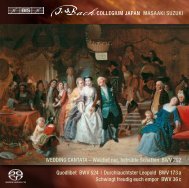You also want an ePaper? Increase the reach of your titles
YUMPU automatically turns print PDFs into web optimized ePapers that Google loves.
<strong>CHAN</strong> <strong>0653</strong> BOOK.<strong>qxd</strong> 20/8/07 3:42 pm Page 10<br />
not materialise and, leaving the Domine<br />
Deus to refer back to the Gloria, we are<br />
pitched forward directly into the agonised<br />
(threefold) plea for intercession on mankind’s<br />
behalf, entrusted to oboe and soprano soloists<br />
in the Qui tollis.<br />
This aria and all that follows in the rest of<br />
the piece can be safely identified as earlier<br />
music recomposed. In the Quoniam it seems<br />
that <strong>Bach</strong> intends to borrow what had been<br />
the false self-confidence of the Pharisee in the<br />
parable – BWV 102’s ‘allzu sich’re Seele’ (all<br />
too certain soul), fiddling unconcernedly while<br />
the fires of hell are stoked – and recycle it with<br />
extra swagger as fitting accompaniment for the<br />
final address to Christ enthroned, altissimus,<br />
but enthroned, tu solus sanctus<br />
notwithstanding, as one of the Trinity – and<br />
the horns and oboes return – cum Sancto<br />
Spiritu. Once again the borrowing is not<br />
wholesale but an expanded version of the<br />
central fugal section of the opening chorus of a<br />
Christmas piece, BWV 40.<br />
So, <strong>Bach</strong>’s ‘Lutheran masses’: misnomer, like<br />
‘church cantatas’? And does it matter? Is it<br />
merely pedantry to hold a torch for <strong>Bach</strong>’s own<br />
distinctions: a handful of single-voice pieces<br />
labelled cantata, a few dialogi and motetti,<br />
otherwise almost anything with a title is called<br />
concerto? If we call everything cantata does it<br />
10<br />
become an unexamined commonplace that<br />
<strong>Bach</strong>’s church pieces are aping opera – precisely<br />
the criticism flung at them by some of <strong>Bach</strong>’s<br />
unsympathetic contemporaries – when in fact<br />
they might only be borrowing techniques and<br />
pressing them into devout theological service?<br />
Maybe considerations of purpose sometimes<br />
get lost in the current debate about ‘correct’<br />
forces for the performance of these works. It<br />
may be that <strong>Bach</strong> would be less concerned<br />
about soli/tutti/ripieni distinctions than about<br />
sacred versus profane.<br />
Similarly, the ‘Lutheran’ masses use almost<br />
no Lutheran raw material, barring the cantus<br />
firmus in the F major Kyrie. Formally they<br />
could just as easily be classed as ‘Neapolitan’<br />
masses, and they are only masses in a<br />
technical sense of Missa, not complete<br />
settings of the Ordinary. They are, however,<br />
deeply Lutheran and <strong>Bach</strong>ian in spirit, music<br />
in which it is hard not to be moved by the<br />
sense of a big and complex resolution of<br />
dissonance. How dispiriting, then, to be<br />
released from their grip back into a world<br />
where people still kill one another, ostensibly<br />
over religious differences. And yet, it is true<br />
that <strong>Bach</strong> too, when younger, produced<br />
music to set these words from the Litany (and<br />
continued to hear them intoned at certain<br />
times of the year throughout his life):<br />
Und uns für des Türken und des Papsts<br />
grausamen Mord und Lästerungen, Wüten und<br />
Toben väterlich behüten (‘And from the horrible<br />
murder and blasphemy, fury and madness of the<br />
Turk and the Pope, Good Lord, preserve us’, – or<br />
as Cornish children once prayed at bedtime:<br />
‘From Ghosties and Ghoulies and Long-leggedy<br />
Beasties, and things that go bump in the night…<br />
Good Lord, preserve us’).<br />
© 2000 Richard Campbell<br />
1 The first theme, now addressed to the ‘Lord’<br />
(Kyrie), is treated in inversion and it has been<br />
suggested that <strong>Bach</strong> originally devised such a theme<br />
as a musical depiction of Heuchelei (hypocrisy). The<br />
insight may be correct but one commentator, at<br />
least, has gone further suggesting that the<br />
denunciatory tone which is required for a successful<br />
performance of the original text is so deeply<br />
embedded in the musical material itself that <strong>Bach</strong>’s<br />
re-use of the music is perverse. Logic here seems to<br />
be swimming upstream against creativity: imitation<br />
by inversion is a self-validating contrapuntal<br />
technique and chromaticisms can be made to plead<br />
for eleison just as effectively as they once sneered at<br />
falschem Herzen (false heart).<br />
Trio Sonata, BWV 529<br />
Organists, high up in their dusty lofts, in<br />
11<br />
Schoenberg’s words, breathe ‘air from other<br />
planets’. Thus it was news to me, when I was<br />
studying in Salzburg in 1981, that <strong>Bach</strong>, who<br />
had, it seems, neglected to compose any<br />
music in the most important chamber music<br />
genre of his time (the two-violin trio sonata<br />
as perfected by Corelli) had in fact written a<br />
set of six trio sonatas, but for the organ alone.<br />
How can a single keyboard player cope<br />
with a trio sonata, which usually requires four<br />
musicians? It was partly advances in pedal<br />
technique that enabled <strong>Bach</strong> to create a<br />
satisfying bass line to the two upper parts,<br />
played with the left and right hands. And this<br />
freedom of the hands was the first problem<br />
that had to be overcome when I set about<br />
arranging the work you hear on this disc. In<br />
particular, the left-hand part would<br />
frequently dip way below the range of the<br />
violin and into the tenor register. In most<br />
arrangements a suitable place is found for an<br />
octave transposition and the music taken<br />
back up within the violin’s range. For me,<br />
however, being the viol player, an<br />
opportunity presented itself to escape from<br />
continuo duty and grab some of the fun<br />
found ‘up there’ among the violins; so I gave<br />
one of the violins some bars’ rest and stole the<br />
line for myself. In doing so, however, I took<br />
as my model trio sonatas by Buxtehude and


